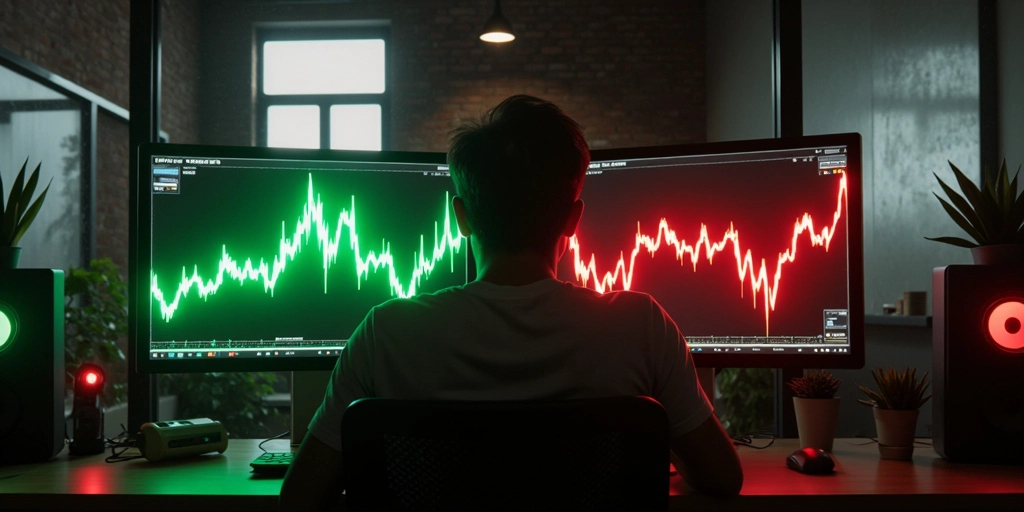Chaos or Opportunity? How Funded Traders Are Winning in 2025
The Volatility is Real: Why This Year is Different If you’ve felt like 2025’s markets have been a rollercoaster, you’re not alone. Between rate cuts, the on-again-off-again nature of US tariffs creating global trade uncertainty, ongoing geopolitical tensions, oil price fluctuations, and Bitcoin’s wild swings, traders are facing volatility levels not seen since 2022. Daily […]

The Volatility is Real: Why This Year is Different
If you’ve felt like 2025’s markets have been a rollercoaster, you’re not alone. Between rate cuts, the on-again-off-again nature of US tariffs creating global trade uncertainty, ongoing geopolitical tensions, oil price fluctuations, and Bitcoin’s wild swings, traders are facing volatility levels not seen since 2022. Daily ranges have expanded across multiple asset classes, and what worked last year simply isn’t cutting it anymore.
While many traders are getting wiped out by overexposure, fear-based decisions, or outdated risk management tactics, a select group of funded traders continues to thrive. We’ve analyzed data from top-performing accounts across major prop firms and interviewed successful traders to uncover what they’re doing differently in this challenging environment.
1. Tactical Risk Adjustments: The New Math of Survival
The first thing that separates successful funded traders from the pack is their immediate adjustment to position sizing.
“I’ve cut my standard risk per trade from 1% to 0.5% in these conditions,” says Michael, a funded trader who’s maintained profitability through Q1 and Q2. “With ATR nearly doubled on my preferred pairs, I’m getting the same dollar movement with half the risk.”
Top traders are implementing several key risk management shifts:
- Reducing standard position sizes by 30-50% compared to last year
- Setting tighter stop losses while accounting for wider average daily ranges
- Using ATR-based stop loss calculations that automatically adjust to volatility
- Taking partial profits more frequently rather than shooting for home runs
This isn’t about trading scared – it’s about adapting to new market physics. When volatility expands, your risk parameters must contract proportionally to survive.
2. Timing & Session Selection: Finding Pockets of Predictability
Another striking pattern among successful funded traders is their heightened awareness of when to trade – and more importantly, when to sit out.
Many have abandoned the traditional NY open – now dubbed the “whip zone” by traders who’ve been burned by false breakouts and stop hunts. Instead, they’re focusing on:
- London close/Asian session “drift” periods with more orderly price action
- Selective news trading, but only when setups offer 3:1 or better risk-reward
- Mid-session consolidation breakouts rather than opening volatility
“I used to trade every session, but now I’m strictly trading London close through early Asian hours,” explains Sophia, who’s passed three prop challenges this year. “Less volume sometimes means more predictable movements.”
3. Strategy Simplification: Why Less Is More in 2025
Perhaps counterintuitively, top-performing funded traders are actually simplifying their approaches rather than developing more complex systems to handle volatility.
“I ditched my 15-indicator system in February,” admits James, who’s been funded for eight months. “Now I’m using a basic support/resistance approach with volume confirmation. My win rate dropped slightly, but my risk-adjusted returns are much higher.”
What’s working now:
- Price action-based approaches with minimal indicators
- Break-and-retest setups on higher timeframes (H4 and daily charts)
- Trading with, not against, established trends
- Simple confluence strategies rather than complex algorithm-based systems
The key insight: complex strategies often become “overfitted” to specific market conditions. When volatility shifts dramatically, these brittle systems break down faster than robust, simple approaches.
4. Prop Rule Awareness: Playing Inside the Lines
The most successful funded traders understand that prop firm rules create boundaries that require strategic adaptation – especially in volatile markets.
Daily drawdown limits, maximum risk parameters, and payout hold rules all influence how top traders approach the market. The best performers are:
- Setting personal daily loss limits 30% below the firm’s requirements
- Tracking correlation between instruments to avoid inadvertent overexposure
- Creating “buffer zones” around critical account metrics
- Scheduling trades around payout windows rather than risking violations
“I’ve seen talented traders get kicked from programs because they pushed right up to the edge of rules during volatile periods,” notes Alex, who manages trader development at a major prop firm. “The pros treat firm parameters as hard boundaries and stay well within them.”
5. Mental Reset & Recovery: The Psychology of Weathering Storms
Perhaps the most underrated skill of top-performing funded traders in 2025 is their mental game – specifically, how they handle the emotional impact of increased volatility.
“I’ve added a mandatory 48-hour cooling period after any day where I hit my personal loss limit,” shares Rachel, who’s been consistently profitable since January. “No exceptions, no matter how ‘sure’ I am about the next setup.”
Other psychological tactics include:
- Daily journaling focused on process over outcome
- Treating “no trade” days as wins when conditions don’t align
- Switching to demo trading during personal emotional volatility
- Scheduled breaks from screens to maintain decision-making clarity
6. What New Traders Get Wrong in This Environment
By examining the patterns of struggling traders, we can identify critical mistakes to avoid:
- Attempting to double accounts quickly while markets are unstable
- Ignoring correlation between traded instruments, creating unintentional overexposure
- Revenge trading after stops are hit, often with larger position sizes
- Constantly switching strategies instead of adapting proven approaches
- Overtrading during volatile sessions, thinking more activity equals more opportunity
As one prop firm manager told us: “The traders who fail in 2025 are the ones trying to trade like it’s 2023. The market has changed, but they haven’t.”
Thriving, Not Just Surviving: The Funded Trader Edge
Volatility doesn’t just separate winners from losers – it creates opportunities for those with the right approach. While many retail traders struggle, funded traders with disciplined risk management and adaptable strategies are posting some of their best months.
The funded traders who continue to succeed in 2025’s challenging markets share three core practices:
- They respect risk above all else, adjusting position sizing to volatility
- They stick to proven setups rather than chasing every movement
- They trade less frequently, observe more, and wait for high-probability opportunities
You can adopt this professional mindset even if you can’t copy their exact trades. The principles that work in volatility are timeless: capital preservation first, consistent execution second, and profits as the natural result of both.
Want to find out which prop firm best matches your trading style in today’s market conditions? Take our 2-minute quiz to discover your ideal funding partner based on your strategy, risk tolerance, and goals.




